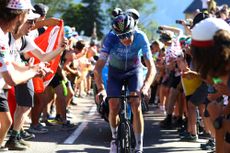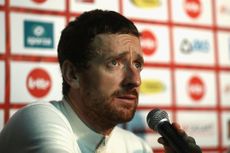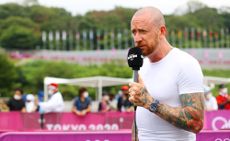Bradley Wiggins: corticosteroid use 'wasn't about trying to gain an unfair advantage'
Sir Bradley Wiggins asserts that his approved use of triamcinolone injections was not for performance-enhancing reasons, but to treat a long-term asthma problem

Bradley Wiggins on stage fourteen of the 2012 Tour de France

Bradley Wiggins, who came out in his defence of recent leaked TUE data this weekend, says that his corticosteroid use was not about trying to gain an unfair advantage in the Tour de France.
Russian hacker group Fancy Bears started leaking athletes' therapeutic use exemptions (TUEs) on its website two weeks ago. Wiggins and Sky's Chris Froome were part of a second data dump on the website. Wiggins's UCI-approved TUE showed he had permission to inject triamcinolone, a corticosteroid, prior to the 2011 and 2012 editions of the Tour, and the 2013 Giro d'Italia – his season's goals for those years.
"This was to cure a medical condition," Wiggins told the BBC One in a pre-recorded interview that aired on Sunday. "This wasn't about trying to find a way to gain an unfair advantage, this was about putting myself back on a level playing field in order to compete at the highest level."
>>> Bradley Wiggins under pressure as ‘injections’ controversy deepens
In the six leaked certificates it was noted that Wiggins had a "life long allergy to pollen."
"It was prescribed for allergies and respiratory problems," the 36-year-old added. "I've been a lifelong sufferer of asthma and I went to my team doctor at the time and we went in turn to a specialist to see if there's anything else we could do to cure these problems," said Wiggins. "And he in turn said: 'Yeah, there's something you can do but you're going to need authorisation from cycling's governing body [the UCI].'"
Cycling's governing body, the UCI, signed off Wiggins's certificate each time. It did so for salbutamol inhalation three times in 2008 and for triamcinolone in 2011, 2012 and 2013.
Get The Leadout Newsletter
The latest race content, interviews, features, reviews and expert buying guides, direct to your inbox!
David Millar, who confessed to doping and returned to cycling and is now a commentator, said that he could not fathom how a doctor could prescribe triamcinolone before a race.
"As I said in my book [Racing Through The Dark], I took EPO and testosterone patches, and they obviously produce huge differences in your blood and you felt at your top level … Kenacort [triamcinolone], though, was the only one you took and three days later you looked different," Millar told The Telegraph.
"You would do all the training but my weight would stick. But if I took Kenacort, 1.5-2kgs would drop off in like a week. And not only would the weight drop off I would feel stronger."

Sky also came under fire because of its no-needle policy and the grey area it entered with Wiggins and triamcinolone. Wiggins said that in his book My Time, he referred to not using needles to dope.
>>> Bradley Wiggins to explain TUE medication on BBC this weekend
"Whoever is leading in the sport at that time, and at the moment it's Team Sky, they're leading the way, and you know, they're setting the standard for everybody," Wiggins told BBC One. "And they're the best of what they do. Unfortunately when you're the best of what you do sometimes comes scrutiny. Especially in a sport that has a tainted history."
The full interview will air on Sunday's Andrew Marr Show on BBC One.
Fancy Bears also released records for other athletes, including cyclists Chris Froome, Laura Trott, Callum Skinner, Steve Cummings (Dimension Data), Fabian Cancellara (Trek-Segafredo), Jack Bobridge (Trek-Segafredo) and Jakob Fuglsang (Astana).
Froome applied for two TUEs at the time of the 2013 Critérium du Dauphiné and the 2014 Tour de Romandie. He received approval for an oral dose of corticosteroid prednisolone – 40mg per day for one week. Froome said, "I've openly discussed my TUEs with the media and have no issues with the leak. In nine years as a professional, I've twice required a TUE."

Thank you for reading 20 articles this month* Join now for unlimited access
Enjoy your first month for just £1 / $1 / €1
*Read 5 free articles per month without a subscription

Join now for unlimited access
Try first month for just £1 / $1 / €1
Gregor Brown is an experienced cycling journalist, based in Florence, Italy. He has covered races all over the world for over a decade - following the Giro, Tour de France, and every major race since 2006. His love of cycling began with freestyle and BMX, before the 1998 Tour de France led him to a deep appreciation of the road racing season.
-
 Zwift's Watopia expands again with new climb
Zwift's Watopia expands again with new climbThe Grade Climb, and 'My List' feature among new updates announced
By Adam Becket Published
-
 Ride the nostalgia trip as Panasonic returns to European cycling after 40 years
Ride the nostalgia trip as Panasonic returns to European cycling after 40 yearsThe electronics branded super-team graced the jerseys and the top of the results lists throughout the Eighties
By James Shrubsall Published
-
 Bradley Wiggins says he suffered ‘borderline rape’ during three years of 'abuse' by coach
Bradley Wiggins says he suffered ‘borderline rape’ during three years of 'abuse' by coachSpeaking on Fearne Cotton’s Happy Place podcast, Wiggins says he now “hates cycling” and only ever used the sport as a distraction
By Tom Thewlis Published
-
 Bradley Wiggins might not be a TV pundit for much longer: 'I just want a normal job really'
Bradley Wiggins might not be a TV pundit for much longer: 'I just want a normal job really'Tour de France champion says that he doesn't still want to be on Eurosport in 10 years, and he thought about being a social worker
By Adam Becket Published
-
 CW Live: Chris Froome targets return to 'top level'; UCI tightens ITT rules; Strava responds to price hike criticism; Topless protesters arrested at TDU; Tributes paid to Lieuwe Westra; Scott recalls 'cracking' bikes; Toon Aerts the PE teacher
CW Live: Chris Froome targets return to 'top level'; UCI tightens ITT rules; Strava responds to price hike criticism; Topless protesters arrested at TDU; Tributes paid to Lieuwe Westra; Scott recalls 'cracking' bikes; Toon Aerts the PE teacherThe latest news in the world of cycling
By Tom Davidson Last updated
-
 Bradley Wiggins: Abuse contributed to making me a great cyclist
Bradley Wiggins: Abuse contributed to making me a great cyclistThe Tour de France winner is part of a new NSPCC campaign to help people spot the signs of child abuse
By Adam Becket Published
-
 Is Bradley Wiggins Rubbish on ITV's The Masked Singer? We investigate
Is Bradley Wiggins Rubbish on ITV's The Masked Singer? We investigateThe wheely bin character was tipped to be the Olympian by one of the judges on the Saturday night TV show
By Adam Becket Published
-
 Bradley Wiggins backs NSPCC campaign for safer sports environments for children
Bradley Wiggins backs NSPCC campaign for safer sports environments for childrenFormer Tour de France champion has spoken about abuse he received from a coach before
By Adam Becket Published
-
 British Cycling offers Bradley Wiggins 'full support' after allegations of sexual grooming
British Cycling offers Bradley Wiggins 'full support' after allegations of sexual groomingThe governing body has contacted Wiggins after he alleged he was sexually groomed as a 13-year-old
By Ryan Dabbs Published
-
 Bradley Wiggins alleges that he was sexually groomed by a coach as a 13-year-old
Bradley Wiggins alleges that he was sexually groomed by a coach as a 13-year-oldFormer Tour de France winner says that it "impacted" him as an adult after he "buried" it
By Adam Becket Last updated